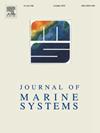Grain-size and geochemical evidence for sediment transport mechanisms in the northeastern part of the East Siberian Sea and on the adjacent continental slope
IF 2.5
3区 地球科学
Q2 GEOSCIENCES, MULTIDISCIPLINARY
引用次数: 0
Abstract
Grain-size analyses, end-member modeling, X-ray fluorescence, and radionuclide activity measurements were conducted on sediment minicores collected from the middle-outer shelf of the East Siberian Sea (ESS) and the upper part of the adjacent continental slope to elucidate the sedimentation mechanisms in this poorly studied region. The grain-size data demonstrate that clayey silt and silt strongly dominate on the ESS shelf and the continental slope. In contrast, sandy silt has a patchy distribution. End-member modeling, applied here for the first time, indicates that sea ice (frazil and anchor ice) rafting, and nepheloid transport are the primary processes responsible for distributing sedimentary material across the ESS. The XRF data confirm the results of previous studies, reporting a predominantly lithogenic origin for ESS deposits. Combined grain size and geochemical records suggests that the shelf break area serves as a depocenter for fine silt particles, likely supplied by nepheloid flow, and represents the most productive area in the northeastern ESS. High sea surface productivity likely results from influence of nutrient-rich Pacific-derived waters, the upwelling of transformed Atlantic-derived waters, or a combination of both. The accumulation of the high amount of fine silt near the shelf break is suggested to be related to relatively calm bottom-water conditions, resulting from the potential interaction of the northward-flowing cross-shelf currents and episodic southward-moving compensatory flows. Wind direction is considered a key factor controlling the intensity of fine-grained material distribution by nepheloid flows and anchor ice across the ESS shelf. Sedimentation rates derived from the radionuclide activity measurements vary from 1.3 mm yr−1 on the outer shelf to 1.0 mm yr−1 on the upper continental slope.
东西伯利亚海东北部及邻近大陆斜坡沉积物输运机制的粒度和地球化学证据
对东西伯利亚海(ESS)中外陆架和邻近大陆斜坡上部的沉积物微粒进行了粒度分析、端元建模、x射线荧光和放射性核素活性测量,以阐明这一研究较少的地区的沉积机制。粒度数据表明,黏性粉砂质和粉砂质在陆架和陆坡上占主导地位。砂质粉砂则呈斑块状分布。本文首次应用的端元模型表明,海冰(巴西冰和锚冰)漂流和nepheloid运输是导致沉积物质在ESS中分布的主要过程。XRF数据证实了之前的研究结果,报告了ESS矿床的主要岩性成因。综合粒度和地球化学记录表明,陆架破碎区是细粉砂的沉积中心,可能是由泥砾石流供给的,是东北中生代最高产的地区。高海面生产力可能是由于营养丰富的太平洋源水的影响,或经过改造的大西洋源水的上涌,或两者兼而有之。陆架断裂带附近大量细粉砂的堆积与相对平静的底水条件有关,这是由向北流动的跨陆架洋流和向南移动的偶发补偿流的潜在相互作用造成的。风向被认为是控制星云流和锚冰在ESS陆架上细粒物质分布强度的关键因素。由放射性核素活度测量得出的沉积速率从外大陆架的1.3 mm yr - 1到上大陆斜坡的1.0 mm yr - 1不等。
本文章由计算机程序翻译,如有差异,请以英文原文为准。
求助全文
约1分钟内获得全文
求助全文
来源期刊

Journal of Marine Systems
地学-地球科学综合
CiteScore
6.20
自引率
3.60%
发文量
81
审稿时长
6 months
期刊介绍:
The Journal of Marine Systems provides a medium for interdisciplinary exchange between physical, chemical and biological oceanographers and marine geologists. The journal welcomes original research papers and review articles. Preference will be given to interdisciplinary approaches to marine systems.
 求助内容:
求助内容: 应助结果提醒方式:
应助结果提醒方式:


